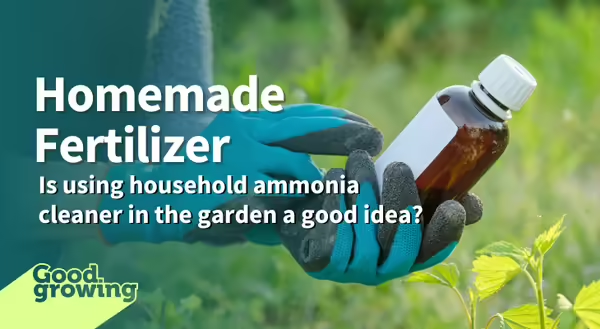
It is time for another installment of What’s under my sink and can I use it in the garden? Today comes a home remedy that originates back to the 19th Century. In 1871, gardener Anne Hale recommended using spirits of ammonia for stimulating flower growth. Over 150 years later, peek under most kitchen sinks today and you will likely find a large jug with the word ‘Ammonia’ somewhere on the label. Can we use household cleaners containing ammonia in our yards and gardens? Short answer – no!
History of ammonia in the garden
It is not uncommon to hear about modern-day gardeners reaching for their own lemony fresh ammonia cleaner to use in their gardens. Many cite the old-world recommendations dating back to Anne Hale as a traditional practice. Let’s keep in mind, historically, humans used to treat illness by bleeding the patient of their tainted blood. Anemia is probably not a great way to overcome the common cold. Some old practices are best left in history. Still, some defend the use of ammonia cleaner as a naturally occurring gas and therefore safer than synthetic chemicals created in labs. And there’s no such thing as a dangerous natural chemical, right?
What has given this practice such a long life is that the chemical ammonia (NH3), does contain nitrogen which soil microbes can convert to become plant available. Meaning gardeners can make their own homemade fertilizer. Plus, a jug of household ammonia cleaner is fairly inexpensive.
Household ammonia cleaners are not made for the garden
Despite the few benefits, household ammonia is not recommended for use in the garden. The main reason is that it is not labeled to be used in the garden. The chemicals in that jug of ammonia were never intended nor designed to be doused on the soil as a fertilizer. The lack of a labeled use for the garden may be enough to stop some gardeners, but not everyone. For those still considering using ammonia as a fertilizer, my arguments against continues.
The problem with online recipes
Using homemade garden mixtures puts you in charge of putting the ingredients together. Concoctions for homemade ammonia fertilizers can easily be found online. The first of many problems is that the recipes vary wildly from a few tablespoons of ammonia per gallon of water to a few cups of ammonia per gallon of water. Secondly, different brands and types of household ammonia cleaners have varying concentrations of ammonia in the jug. They are not all the same. Rare is it to find a recipe for homemade fertilizer that also states what concentration of ammonia is in the original jug. Depending on the concentration of ammonia you could under or over-fertilize your plants. In some cases, applying excessive amounts of nitrogen. And excessive does not equal better when it comes to soil nutrients.
The chemistry of ammonia
Are you still considering a homemade ammonia fertilizer? Well, let’s look at the chemistry of what’s occurring. Ammonia is not a liquid. It is a gas that has been dissolved in the liquid of the cleaner. Because ammonia is lighter than air, it readily vaporizes into the atmosphere. That’s why your ammonia-based window cleaner evaporates so quickly, leaving a streak-free shine! As you expose ammonia to the open air through mixing and applying to the garden, that nitrogen is quickly escaping.
When ammonia dissolves in water a few compounds are created. One of these is called aqueous ammonia, which is toxic to plants, especially seedlings. The levels of the varying ammonia compounds change depending on the pH of the environment they interact. Mixing your household ammonia cleaner into alkaline water (pH 7 or higher) or dumping it onto an alkaline soil, increases the amount of aqueous ammonia, thereby making it more toxic to plants.
I can’t stop anyone trying to kill something or help something in their garden by pouring household cleaners on their soil. However, I can still be the voice asking, “Are you sure that’s a good idea?”
Good Growing Tip of the Week: Don’t know your soil pH? You can learn about testing your soil to discover the pH and nutrient levels at extension.illinois.edu/soil.
Bonus tip: Most labs don’t measure nitrogen levels because it varies widely throughout the year and is so unstable in samples.
Sign up for our emails! Want to get notified when new Good Growing posts are available? SIGN ME UP
MEET THE AUTHOR
Chris Enroth is a horticulture educator with University of Illinois Extension, serving Henderson, McDonough, Knox, and Warren counties since 2012. Chris provides horticulture programming with an emphasis on the home gardener, landscape maintenance personnel, and commercial landscapers. Additional responsibilities include coordinating local county Master Gardener and Master Naturalist volunteers - providing their training, continuing education, advanced training, seasonal events, and organizing community outreach programs for horticulture and conservation assistance/education. In his spare time, Chris enjoys the outdoors, lounging in the garden among the flowers (weeds to most).